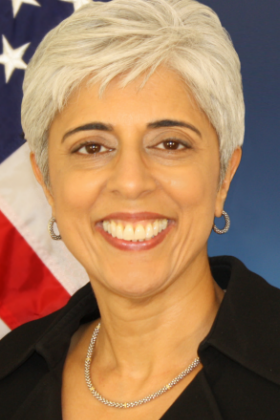DARPA chief: Military's focus on big systems 'is now killing us'
Prabhaker says Pentagon has to shed its expensive, slow-moving approach to technology and new weapons.
The Microsystems Technology Office within the Defense Advanced Research Projects Agency, the source of much chip innovation over the past two decades, is now at the forefront of efforts to solve nagging cost and complexity issues that plague many modern weapons systems.

During the Cold War, the United States possessed the deep pockets to build complex, monolithic systems without regard to cost. That strategy "is now killing us," said DARPA Director Arati Prabhaker, who founded MTO during her first stint at the agency during the Clinton administration. "It's a self-inflicted wound."
Prabhaker said MTO is playing a key role in moving the military away from "point sources of vulnerability"—centralized, monolithic systems such as the Global Positioning System. These large systems also resist upgrades even as the pace of technological development speeds up.
The Pentagon must "break this monolithic, high-cost, slow-moving, inflexible approach that we have," added Prabhaker, who was speaking during a recent technology exposition for potential contractors. She sees MTO playing an important part in creating the agile underlying technologies needed for future weapons, satellites and networks.
Despite its new mission, MTO also finds itself searching for a new role, as the emphasis on "microsystems" shifts steadily from hardware to software. Again, that shift has resulted in greater cost and complexity for weapon systems, and DARPA officials say that remains a key challenge for the agency in the coming era of declining military spending.
Several MTO programs were shifted in April to a new Biological Technologies Office. New MTO Director William Chappell conceded that funding for MTO efforts is now "flat." The agency does not break out budget totals for individual technology offices, a spokesman said.
MTO continues to invest in new semiconductor materials, including a big effort in gallium nitride. A DARPA initiative last year demonstrated what it claimed was a chip industry first, the GaN-on-diamond transistor that could find its way into military RF systems.
While MTO continues to invest in device technology, Chappell said that the military has failed to confront the technological complexity, most of it brought about by software technology. He acknowledged that the services have largely failed to take advantage of an emerging "software-defined world." The result has been skyrocketing weapons costs.
As MTO gradually shifts its emphasis from hardware to software, Chappell added that it wants to invest more resources in algorithm development and circuit design. One example is the growing need for algorithms to enable "dynamic spectrum sharing," a capability would allow the military to squeeze more capacity out of increasingly scarce electromagnetic spectrum. The effort is gaining urgency as the military is being pressed to vacate "beach front" spectrum being designated for commercial wireless applications.
Meanwhile, DARPA also is looking farther afield as the globalization of technology gains momentum. "In the past we sort of buried our head in the sand," Prabhaker said. Now, there's a "willingness to try to adapt because we don't have a patent on good ideas."